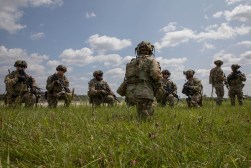Army looking for industry input on low-Earth orbit capabilities for next-gen blue force tracker

The Army is soliciting proposals from industry to examine what capability exists for current and future low-Earth orbit satellite constellations as part of modernization efforts related to its blue-force tracker system.
So-called blue force tracking allows units to keep tabs on the whereabouts of other friendly forces on the battlefield for command and control.
Project manager for mission command within the Army’s program executive office for command, control and communications-tactical released the request for information Nov. 16. It asks vendors to describe recent experience within the last three years and capabilities providing certain requirements for LEO.
The effort is part of the Army’s network modernization efforts as it moves to improve communications both within the tactical sphere and all the way back to the enterprise level. The service has been undergoing a multiyear effort it describes as the unified network, which merges the prior tactical and enterprise instantiations into a singular entity in which troops can access data all over the world regardless of theater or echelon.
The next-generation blue-force tracker capability, called Mounted Mission Command-Transport, will provide improved situational awareness and command-and-control message delivery as well as satellite communication capabilities by increasing resiliency and integrating additional communications pathways, according to the Army. That program is scheduled for low-rate initial production in fiscal 2025 and full-rate production in fiscal 2026.
The RFI is part of market research the Army is conducting to help inform possible technical advances in the commercial sector and integration with LEO capabilities. The notice will cover modules inside the new MMC-T transceivers as well as commercial constellations readiness that could support blue-force tracker transport as part of the overall Mounted Mission Command program.
Specific characteristics highlighted in the notice include, among others, user terminal size options, can terminals operate on the move, do they include proprietary software and can terminals support multiple constellations.
The Army wants resiliency when it comes to position, navigation, and timing (PNT) capabilities. The service desires tech that doesn’t rely on GPS for the ground terminal to function, the RFI noted.
Responses are due Dec. 22.






